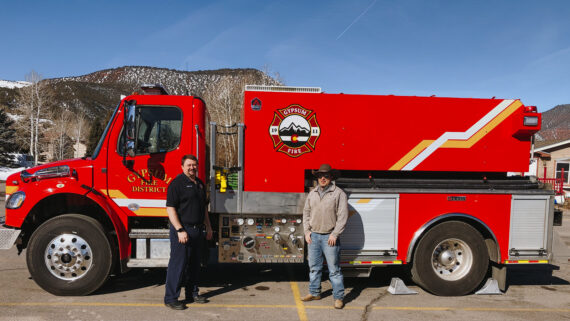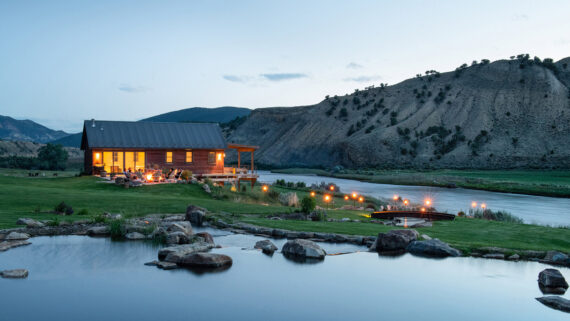Colorado River Ranch: Refining the Untamable Wild West
Contrary to popular belief, no one tames the Wild West we can only learn to live in harmony with Mother Nature as she graces us with her bounty, entrances us with her beauty and humbles us with her power. The early homesteaders were seeking to do just that — some succeeded, many failed. But the pioneering spirit that drove those first ranchers and farmers is still alive and thriving in today’s Colorado Rocky Mountains.
For many modern ranchers in Eagle County this has been a way of life for generations. They have followed their roots in the grueling lifestyle of true ranchers and real cowboys who made these rugged mountains a place to call home. Some of the newcomers to the ranching community are the “gentlemen farmers” who are only seeking a brief escape from the hustle and bustle of the city for a momentary step back in time, complete with “rancher” bragging rights to carry home.
Today this is an area that hosts many different ranching dreams, from those who have worked the ranch for over a century, to those jetting in for a weekend — and every conceivable thing in-between. One family with a dream began their journey with a home in Beaver Creek. A love for the Vail area, the thrill of horseback riding in the mountains and a chance dining encounter with a Wagyu steak led them to ownership of the Colorado River Ranch (CRR), and an ongoing adventure of a lifetime.
Thirteen miles north of Dotsero, surrounded by mountains with the Colorado River running through it, the beauty of the valley takes your breath away. The 1,017-acre CRR ranch spreads across the valley as the bucolic view, with cows and horses grazing, all adjacent to thousands of acres of BLM land. This idyllic spot and a passion to have a modern-day working ranch raising cattle has created a new lifestyle for this family that fuses the past with the present in a manner our forefathers never could have envisioned. “Ranching in rhythm with nature” is the mission in which the owners of CRR have chosen to use their property. And the real beauty of this ranch shines from the inside out!
Steeped in history, CRR is one of the older historic working ranches in Eagle County. In 1859 when gold was discovered in Colorado, followed by the detection of silver, many adventurers were attracted to this area. Such explorers, Sam and Frank Doll, combined their talents in the 1870s and purchased tens of thousands of acres in the area, naming it Grand River. In 1923 they added CRR to their holdings, obtained in a sheriff’s sale. The fertile acres were ideal for raising livestock which had drawn early homesteaders.
Over the years, the ranch changed hands, with the first new owners, the Schultzes, renaming it Willow Creek Ranch. In 1964 William F. Stevens bought the ranch, along with adjacent land. Bill and Neva Nottingham took on the neglected ranch in 1985 and ran a cattle operation until selling to Cordillera for a golfing- residential development, which never came to fruition. Then, in 2008, River Ranch LLC purchased the ranch and put a conservation easement on the property.
And finally, in 2014, the current owners purchased the property. Seeking a place to ride horses, raise Wagyu beef and toil alongside their ranch managers, they have returned it to working ranch status and are focused on protecting the environment as they preserve its agricultural heritage.
As the largest remaining ranch in the Upper Colorado Conservation & Recreation Project Area and within the Bureau of Land Management (BLM) Special Recreation Management Area, CRR hosts a large herd of Wagyu cows bred and raised naturally under organic principles, as are their horses, chickens and goats. When the owners pursued their desire to be cattle ranchers, raising the very best was their goal and Waygu cattle fulfilled that objective.
“We operate in harmony with nature as stewards of the land,” says Scott Jones, CRR manager with his wife, Jennifer. “By us taking good care of our land, it takes good care of our cattle and the environment.”
They rotate the cattle grazing areas so there is always enough left to foster the wildlife and time to revitalize the soil; the cattle graze in Wolcott in the summer so the fields can be replenished with the grass hay or alfalfa the ranch raises for feed. And true to their heritage the cattle are herded on horseback.
Shades of the Old West certainly come to play during branding time. Calves are branded early to determine ownership. Colorado is a “brand state” meaning, just like in the olden days, if a cow is unbranded there is no claim to ownership. Unlike most operations where calves are taken to feed lots once they’re weaned, CRR maintains care until fruition, 36 to 40 months, feeding on high-protein grass, superior in the high altitude, until they are processed.
“The Wagyu cows we raise here go from farm to table,” says Jones. “We oversee our cattle from birth until the day they are processed so we are sure they meet our standards for the highest quality meat and care available.” Since modern day ranchers are looking for a finer home than the rough quarters early-day settlers experienced, CRR brought in a powerful team of visionaries to bring refinement to their dream. Working together a stunning and comfortable living environment was created in the “New West.”
The first building to be tackled was the “Red Barn,” no longer in use even for the livestock. Committed to working with local artists to bring their vision to life, they contacted local architect Tom Cole. Their desire was to combine traditional natural elements like wood, stone and oxidized metal to create an organic look, as if it were a natural part of the landscape. Cole created an exquisite image for all the buildings that presents an inspired look honoring the Wild West of yesterday with the contemporary lines of today. Builder Tom McCord of McCord Construction and interior designer Tracie Schumacher of Studio 80 Interior Architecture & Design brought these ideas into reality.
“In the beginning the owner was already working with Tom, and our team had the task of bringing an old cattle barn back to life using the exact footprint,” says Schumacher. “It was the first building project on the ranch and was a good way for all of us to learn about each other and to understand the owner’s taste.”
Mountain modern with clean simple lines, a space that was casual and practical, and using many traditional elements to tie the past to the present was the direction. And as Schumacher pointed out, “the devil is in the details.” “This is one of the most gorgeous pieces of land I’ve ever seen. So, when you have to take a crumbly, broken down barn and make it into something special — when you have to compete with the beauty of nature — how do you blend the two in a way that is beautiful? The challenge is how to get everything talking to each other.”
The entire design of merging traditional with modern joined seamlessly under Schumacher and Cole’s hands. Repurposed Wyoming wind fencing unites with metal; suede cabinet fronts with leather pulls create a soft touch; the coil kitchen bar stools with wooden seats are pieces of art; animal hides, wood tiles and polished cement flooring also integrate the comfortable and beautiful with the practical. This is a place where dogs can run, dirty cowboy boots can be accommodated, and everyone can feel relaxed in an exquisite atmosphere.
“We chose the lighting pendants [by Human Scale] because when they are lit at night it reminded me of raindrops or stars. It was just one of the ways we brought the outside in — it was one of the many elements that enhances the feeling of being outdoors,” says Schumacher.
The glass garage door that spans one side of the top floor not only captures the views of the Colorado River and the cliffs beyond but rolls open into the ceiling to invite the fresh mountain air inside. The sturdy, comfortable outdoor furniture surrounds a metal gas firepit to add warmth and ambiance to any gathering. It’s the perfect place to congregate and enjoy the camaraderie of family and friends while basking in the glow of Mother Nature.
With the same fine attention to detail, an expansive water feature complete with cascading waterfalls and a large pond further enhances this delightful area. The rocks used to create this tranquil scene are from neighbor ranchers. A native rock path leads down to another patio area and firepit that can be enjoyed while watching the lazy, flowing river. To approach the next project the owners asked their ranch manager what was needed to assist the operation. He responded with “a horse barn.” But he certainly did not envision the remarkable finished product. The huge horse barn was the second project the design team took on, and the ranchers of yesteryear would have been dazzled — frankly, today’s ranchers would be dazzled. There are horse stalls and tons of storage space. But the tack room is a twenty-first century marvel. A barnwood wall magically revolves from a center axis and spins to reveal the backside of the “wall” covered with neatly stored tack. It uniquely serves as the door into the rest of the hidden tack storage room.
The upper level of the barn entertains a large covered patio, with a beautifully appointed bar and overlooks the horse arena. It’s the perfect shaded area from which to watch horses train while sipping a lemonade or cocktail and discussing the progress in the arena below. Or just relax while enjoying a spectacular sunset.
In the barn there are dog wash stations, rooms where baby ducks incubate, and refrigerators to store eggs of all different colors from the many varieties of chickens raised on the ranch.
The chickens can assist with the farming aspect of the ranch by living in a mobile coop. At appropriate times the coop is transported to various areas of the cattle field where mobile fences are erected to protect the chickens from predators. Their job is to peck and scratch throughout the fields to disperse “fertilizer” and find worms to eat. This all ties into the mission of being in “rhythm with nature” — everything giving back to the land that supports the people and all the critters.
Accompanying the cattle and myriad of chicken are horses, several goats (who have their own playground that even includes a trampoline to play on); dogs and ducks.
They all live in harmony with the wildlife that have taken up residence on the ranch. Bald eagles are so content in this setting that this year, one nesting couple has given birth to three baby eaglets — very rare in the animal kingdom. There are playful river otters who drift along the current of the river keeping an eye out for coyotes, bears, deer, elk and mountain lions. And the fishing is great.
After the horse barn was completed, a large bunkhouse was the next project for this design and building team and they, once again, made magic happen. The striking vision Colorado River Ranch presents, with its rust colored metal roofs, emerald green pastures and the Colorado River winding its way across the property, is a remarkable example of one of the many faces of the modern ranch.
For this property, the accouterments for luxury living are clearly there; the development for raising the finest cattle has been employed and the Western spirit is on full display. “Ranching in rhythm with nature” — mission accomplished.
Authors note: One of the most fascinating things I learned while working on this feature is this: a cow can jump, flat- footed, a six-foot-high fence — a big, heavy ungainly cow leaping six feet up in the air! And in fact, a pregnant cow can do this. Mother Nature is an endlessly astonishing thing to behold.
This article originally appeared in Vail Valley



